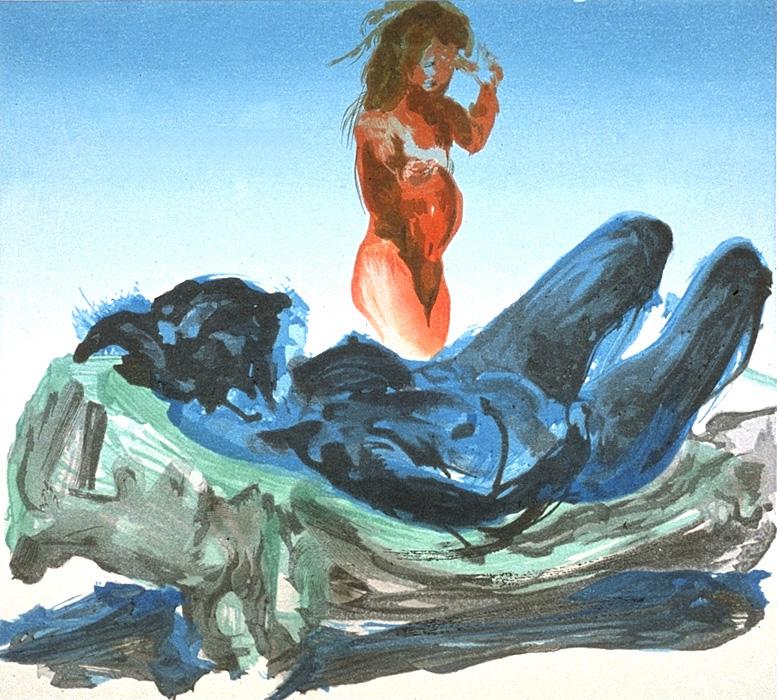Eric Fischl
I think my work is most successful when the audience connects with what they are seeing emotionally, but what they are seeing is so complex that it never gets tied down. It's like theater without a script, a set of relationships between people, the objects, and the place that they are in.
Eric Fischl was born in New York, began his art education at the Phoenix College in Arizona, and earned a BFA at the California Institute of the Arts in 1972. After graduating, he took a job as a museum guard at the Museum of Contemporary Art in Chicago where he first saw the work of the “Chicago Imagists” and the “Hairy Who.” The raw and unconventional style of these groups inspired Fischl. Though he was trained in abstract expressionism, he started painting figurative work, and eventually began painting morally ambiguous narratives in the setting of American suburbia.
Fischl’s early paintings expose private moments of sexuality from adolescence to adulthood. Sleepwalker (1979) shows a boy masturbating in a wading pool with two empty lawn chairs nearby. Bad Boy (1981) lets the viewer peak over the shoulder of a young boy watching an adult woman lying naked on her bed while he slips his hand into her purse. Of Fischl’s narrative, Roberta Smith of the New York Times writes “Mr. Fischl at his best is a teller of nonstories, of passing thoughts, indefinable tensions and denouements too negligible to notice. They lurk just beyond the reach of the camera or the playwright, and are best magnified and prolonged by dint of being painted.” Suburbia is not Fischl’s only subject. He has also painted dancers in India, matadors in Spain, sculptures and museums in Rome, and crowds at the beach. Many of his figures are nudes painted in lush colors with a glowing light source. Recent paintings show well-known faces such as those of Simon de Pury, Francesco Clemente, and Steve Martin.
Fischl generally paints from photographs, sometimes collaging together parts of multiple images and painting the new scene on canvas. He has also worked in the mediums of sculpture and print. His 2001 bronze sculpture titled Tumbling Woman, made in respect to 9/11, features a naked woman lying on her back with all limbs up in the air, as if free falling. When presented at the Rockefeller Center in 2009, the sculpture proved to be controversial, sparking many complaints. It was curtained-off and then removed within a week. Fischl has made lithographs, monotypes, aquatints, and solar prints. He worked with Crown Point Press in 1988, creating an untitled colored woodblock print carved with painterly strokes.
Fischl’s political view of America gives insight to his often dark suburban imagery: “I think that the best art that’s being done today in America deals with the crisis of American identity, the failure of the American dream, and how overtaxed we are, both politically and in terms of what we think things mean…we’ve watched the way America has grown and acted and it doesn’t match the ideal,” (from Paintings, page 26, 1985). Fischl is the founder of “America: Now and Here,” a mobile tour of 18 trucks that connect to form a gallery featuring artists of film, photography, poetry, and music. It travels across the country challenging the perception of America as presented by mainstream media.
Eric Fischl was born in 1948. He taught painting at the Nova Scotia College of Art and Design in Canada starting in 1974. His first solo show was in 1975 in Nova Scotia at the Dalhousie Art Gallery. He moved back to his hometown of New York City in 1978 and married fellow painter April Gornik. His work has been exhibited at the Institute of Contemporary Arts in London, England; the Louisiana Museum of Modern Art in Humlebaek, Denmark; the Museum of Modern Art in New York City; and the San Francisco Museum of Modern Art in San Francisco, California. He is a Fellow of the American Academy of Arts and Letters and the American Academy of Arts and Science. Eric Fischl is represented by the Skarstedt Gallery in New York City and is a senior art critic at the New York Academy of Art. He lives in Long Island with his wife, the artist April Gornik.
-Hana Haber, Crown Point Press
